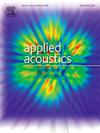基于增强多重随机傅立叶特征的广义最大熵有源噪声控制算法
IF 3.4
2区 物理与天体物理
Q1 ACOUSTICS
引用次数: 0
摘要
基于随机傅立叶滤波器的FxLMS (RFFxLMS)算法通过有效降低内存需求和计算复杂度,大大增强了传统核方法在主动噪声控制中的应用。此外,它通过其非线性自适应能力克服了传统FxLMS的线性限制,在复杂的声学环境中实现了卓越的噪声抑制。为此,本文提出了一种增强的基于多重随机傅立叶特征的广义最大熵准则(EMRFF-GMCC)算法。与RFFxLMS及其扩展不同,EMRFF- gmcc算法结合投影矩阵来开发EMRFF方法,提高了复杂场景下的非线性映射、适应性和降噪性能。通过利用这些特征的共享属性,该算法在整体性能上取得了显着改善,使其在处理动态和具有挑战性的噪声环境时更有效。此外,用广义最大熵准则(GMCC)代替均方误差(MSE)代价函数,显著增强了对异常值的鲁棒性。仿真和管道实验验证了所提出的EMRFF-GMCC算法的有效性,展示了其在不同噪声环境下的优越性能,并巩固了其作为实际应用中有希望的候选算法的潜力。本文章由计算机程序翻译,如有差异,请以英文原文为准。
Enhanced multiple random Fourier features based generalized maximum correntropy algorithm for active noise control
The random Fourier filters-based FxLMS (RFFxLMS) algorithm significantly enhances traditional kernel methods in active noise control (ANC) by effectively reducing memory demands and computational complexity. Additionally, it overcomes the linearity constraints of conventional FxLMS through its nonlinear adaptive capability, enabling superior noise suppression in complex acoustic environments. Therefore, this paper proposes an enhanced multiple random Fourier features based generalized maximum correntropy criterion (EMRFF-GMCC) algorithm. Unlike RFFxLMS and its extensions, the EMRFF-GMCC algorithm incorporates a projection matrix to develop an EMRFF method, improving nonlinear mapping, adaptability, and noise reduction performance in complex scenarios. By leveraging the shared properties of these features, the algorithm achieves a significant improvement in overall performance, making it more effective in handling dynamic and challenging noise environments. Furthermore, the mean square error (MSE) cost function is replaced by the generalized maximum correntropy criterion (GMCC), significantly enhancing robustness against outliers. Simulations and duct experiments validate the effectiveness of the proposed EMRFF-GMCC algorithm, showcasing its superior performance across diverse noise environments and solidifying its potential as a promising candidate for real-world ANC applications.
求助全文
通过发布文献求助,成功后即可免费获取论文全文。
去求助
来源期刊

Applied Acoustics
物理-声学
CiteScore
7.40
自引率
11.80%
发文量
618
审稿时长
7.5 months
期刊介绍:
Since its launch in 1968, Applied Acoustics has been publishing high quality research papers providing state-of-the-art coverage of research findings for engineers and scientists involved in applications of acoustics in the widest sense.
Applied Acoustics looks not only at recent developments in the understanding of acoustics but also at ways of exploiting that understanding. The Journal aims to encourage the exchange of practical experience through publication and in so doing creates a fund of technological information that can be used for solving related problems. The presentation of information in graphical or tabular form is especially encouraged. If a report of a mathematical development is a necessary part of a paper it is important to ensure that it is there only as an integral part of a practical solution to a problem and is supported by data. Applied Acoustics encourages the exchange of practical experience in the following ways: • Complete Papers • Short Technical Notes • Review Articles; and thereby provides a wealth of technological information that can be used to solve related problems.
Manuscripts that address all fields of applications of acoustics ranging from medicine and NDT to the environment and buildings are welcome.
 求助内容:
求助内容: 应助结果提醒方式:
应助结果提醒方式:


